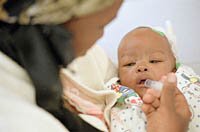| |
Nursing Education Program
|

The curriculum contains a module covering practical information on nutrition for HIV-infected individuals living in Africa
|
Program Update:
Nursing Curriculum Available Online
The full text (including illustrations) of the second edition HIV Curriculum for the Health Professional is now available on-line in .pdf format. Each module can be downloaded individually, so you can print only the modules that are most relevant for your program. You can also download the entire curriculum. View curriculum.
This edition of the curriculum has been re-written to reflect BIPAI's growing experience in conducting training in southern Africa. For example, answers to frequently asked questions by health professionals are included in the text of the revised modules. The curriculum has been re-named HIV Curriculum for the Health Professional, based on our experience that in addition to nurses, doctors, counselors, and others may benefit from the material.
Hard copies of the curriculum are provided free-of-charge to individuals in developing countries. A fee of $15 each is charged for copies of the curriculum sent to individuals in the United States and Canada. This $15 fee is used to offset costs of providing the curriculum free-of-charge to health professionals in the developing world. This fee can be waived under special circumstances on a case-by-case basis. Please contact Meg Ferris, M.P.H. at with questions or special requests. Checks should be made payable to Texas Children's Hospital, and sent to:
Meg Ferris, M.P.H.
Texas Children's Hospital
Clinical Care Center
, CC 1570
Houston, Texas 77030
Over 1,100 copies of the first edition collaborative HIV nursing curriculum binder were distributed in 47 nations. Train-the-trainer-style educational programs for nurses based on the curriculum, have been conducted by BIPAI staff in 2002 in South Africa, Swaziland, Zimbabwe, Botswana, Namibia, Lesotho, Malawi, Tanzania, Kenya, the Seychelles, Mauritius, Mozambique, Zambia, and for participants from the Democratic Republic of Congo and Angola. These educational programs were held as part of a curriculum implementation plan funded by the Bristol-Myers Squibb Secure the Future program, and offered in coordination with the SADC AIDS Network of Nurses and Midwives (SANNAM), and UNAIDS. SANNAM is an organization composed of representatives from the nursing associations of all 14 SADC nations. Workshop evaluations reflect that they have been very well-received in the nations where they have been conducted to date. Each country is eligible to apply for up to $5,000 in seed funding upon completion of each workshop. This funding is intended to be used by the National Nursing Association in each country to continue to educate nurses using the train-the-trainer approach. Applications for seed funding that have been received to date have been well documented and well justified. This nursing curriculum implementation was presented at the XIV International AIDS Conference in Barcelona, Spain, in July, 2002. A curriculum implementation wrap-up and evaluation workshop was held in February, 2003. Plans for the way forward were discussed. Training workshops have been held in 2003 in Uganda, Cameroon, and Mali.
|

A module on prevention of mother to child transmission reviews effective interventions
|
Curriculum Development
This collaborative HIV/AIDS nursing curriculum was developed jointly with colleagues in southern Africa. Members of the Baylor International Pediatric AIDS Initiative conducted an initial needs assessment in Africa in June of 1999. It was immediately confirmed that simply conducting educational programs for HIV nurses would not have the long-lasting impact that is necessary to begin to combat the epidemic in Africa. Although challenging, with encouragement from African collaborators, Baylor chose to undertake the development of a comprehensive curriculum on HIV/AIDS, to eventually be implemented in schools of nursing throughout Africa. Development of the initial draft curriculum occurred between July, 1999 and March, 2000.
Pilot Testing the Curriculum
In April 2000 the collaborative HIV Nursing Curriculum was pilot tested in South Africa and Swaziland. Two-day conferences were held at the Medical University of South Africa (MEDUNSA) in Pretoria, and at the College of the Nazarene School of Nursing in Swaziland. The conference content included both didactic presentations and interactive sessions. Didactic presentations were given either by Baylor College of Medicine or local faculty. Content was based on the HIV Nursing Curriculum and included lectures regarding pathophysiology, the epidemiology of HIV in southern Africa, HIV/AIDS diagnostic criteria, opportunistic infections, antiretroviral therapy, traditional healing practices, and end of life care. In addition to the didactic presentations, three interactive sessions were conducted in a train-the-trainer format. Participants chose two of the three sessions to attend. The sessions included; 1) How to be an HIV/AIDS educator, 2) Issues in HIV/AIDS counseling, and 3) Establishing support groups for persons with HIV/AIDS. Baylor College of Medicine faculty worked with the participants in small groups, or individually during these sessions. In the first session participants received didactic information on adult learning theory, how to plan a lecture for a specific audience, how to work with different types of learners, and how to organize and deliver a brief lecture. Small group activities included the preparation of a brief lecture that was presented to the large group. The modules in the nursing curriculum served as content for these short talks. Students critiqued their own lecture after the presentation, and also received feedback from the group as well as from the Baylor faculty. Individuals in the second session focused on HIV/AIDS counseling principles including effective counselor personality qualities, counseling skills, constructive feedback, stages of the counseling relationship, and the importance of trust and confidentiality. Small group exercises were used to learn these principles. The third group discussed practical issues involved in establishing support groups for individuals infected with or affected by HIV/AIDS. This group was facilitated by a social worker. Content included goals and objectives of support groups, how to conduct a needs assessment, what type of provider is qualified to lead support group meetings, and how to follow up with participants or provide referral to outside resources as needed. At the conclusion of each pilot conference, selected local participants (including nurses, physicians, public health specialists, and hospice workers) met with the Baylor faculty and were asked to provide feedback regarding the curriculum content. Their comments were integrated into the final HIV Nursing Curriculum in an attempt to make it more culturally sensitive and regionally appropriate.
Curriculum Description
The curriculum is comprised of 22 individual modules. Each module consists of objectives, key points, written lecture material (approximately eight to ten pages in length for each module), review questions, exam questions, case studies, and overhead transparencies, which illustrate the material. The curriculum was designed in a modular format and published in a binder so that it can be adapted for use in different ways. One instructor might choose a single module to supplement the information on HIV in a community nursing course. Another might choose a group of modules to provide a more complete review of, for example, HIV clinical manifestations. All the modules can be used together to form a comprehensive semester-long specialty course on HIV. The curriculum was written intentionally to be Afro-centric. The case studies all involve typical African settings, and feature individuals with African names. African concerns about HIV are specifically addressed. However, six of the modules have already been re-written to be more specific for the Romanian setting. The basic facts about HIV infection do not change according to the setting. With significant adaptations, the curriculum could be used in training nurses and other health professionals interested in HIV worldwide.
The curriculum begins with a module on the global epidemiology of HIV, including information on the origins of HIV, the ways that HIV is commonly transmitted, and a description of the global spread of the disease. The next module describes the pathophysiology of HIV, including the normal immune system, the affect of HIV on the immune system, and the HIV lifecycle. A module on the diagnosis of HIV infection explains the diagnostic tests and clinical findings which identify the presence of HIV. A series of modules on clinical manifestations of HIV include oral and cutaneous manifestations, HIV-associated malignancies, neurologic and developmental manifestations, pain as a manageable symptom of HIV disease, gastrointestinal signs/symptoms, and common illnesses associated with HIV. Another module describes the prevention and management of common opportunistic infections. The module on antiretroviral treatment details therapeutic goals, principles of antiretroviral therapy, monitoring of patients receiving therapy, and barriers to treatment. The curriculum includes an in-depth review of HIV counseling principles and skills, and another module covers the specifics of pre- and post-test counseling. The module on psychosocial issues provides an overview of some of the common ways HIV affects peoples lives that nurses need to be aware of. The module on primary care outlines nutritional factors and childhood immunizations. The module on complimentary care outlines some of the additional strategies that are commonly used to treat HIV. Finally, modules on prevention and control include one on the prevention of sexual transmission, one on the prevention of perinatal transmission, and one on standard precautions and post exposure prophylaxis.
|